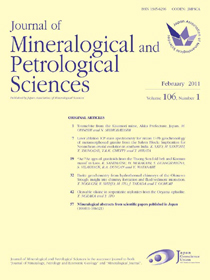巻号一覧

98 巻, 1 号
February
選択された号の論文の5件中1~5を表示しています
- |<
- <
- 1
- >
- >|
REVIEWS
-
Charles T. PREWITT原稿種別: Others
専門分野: Others
2003 年 98 巻 1 号 p. 1-8
発行日: 2003年
公開日: 2004/03/31
ジャーナル フリーMineral physics is a relatively new category used by geoscientists to describe the field of research that involves measurement and characterization of the physical, and to a certain extent the chemical, properties of minerals under varying pressure, temperature, stress, and chemical environment. Great progress has been made in the past 20 years because of the availability of major research facilities, new instruments, and new and improved techniques. Areas of special interest in which mineral physics plays a significant role are the study of deep-earth mineralogy, environmental mineralogy, and interactions among minerals and biological systems. There are many problems yet to be solved by applying the techniques described here along with new developments yet to come.抄録全体を表示PDF形式でダウンロード (641K) -
Andrew PUTNIS, Carlos M. PINA, Jose M. ASTILLEROS, Lurdes FERNÁ ...原稿種別: Others
専門分野: Others
2003 年 98 巻 1 号 p. 9-18
発行日: 2003年
公開日: 2004/03/31
ジャーナル フリーThe study of mineral surfaces has been revitalised by the application of Atomic Force Microscopy to problems of nucleation and growth. In situ observations of crystal growth of BaSO4 and SrSO4 in a fluid cell in an Atomic Force Microscope (AFM) reveals the role of the crystal structure of the substrate in controlling spiral growth and two-dimensional nucleation. The growth of solid solution crystals is considerably more complex. The variation of the supersaturation of a given aqueous solution with respect to each solid composition leads to the possibility that different compositions can simultaneously grow by different mechanisms on the same crystal face. These predictions are compared with direct AFM observations of crystal growth of the (Ba, Sr)SO4 solid solution.抄録全体を表示PDF形式でダウンロード (4990K)
ORIGINAL ARTICLES
-
Masaki YUHARA, Takashi MIYAZAKI, Hiroo KAGAMI, Mie YUHARA原稿種別: Others
専門分野: Others
2003 年 98 巻 1 号 p. 19-30
発行日: 2003年
公開日: 2004/03/31
ジャーナル フリーThe Rb-Sr and K-Ar geochronological study was made for the Aji Granite in the eastern Sanuki district, one of the fine-grained granites in the Ryoke Belt. This granite is divided into hornblende-free and hornblende-bearing facies. The former gives a Rb-Sr whole-rock isochron age of 82.9±8.0 Ma with SrI of 0.70773±0.00007 which is interpreted as the intrusive age of the Aji Granite and therefore the final plutonism in the eastern Sanuki district. Biotites separated from six samples give K-Ar biotite ages between 80.4 Ma and 79.4 Ma. K-Ar hornblende age is of 83.5 Ma. These age data suggest rapid cooling after the emplacement of the granite. The initial Sr and Nd ratios of the Aji Granite fall within the range of the Ryoke granitoids. They are close to those of the Fine-grained Granite in the Awaji Island, but differ from those of the Busetsu, Kadoshima and Otagiri Granites in the Chubu district. The Aji Granite and Fine-grained Granite in the Awaji Island have I-type granite chemical characteristics, whereas other fine-grained granites in the Ryoke Belt have S-type characteristics. This suggests varying source characteristics for the fine-grained granitic magmas in the Ryoke Belt.抄録全体を表示PDF形式でダウンロード (4254K) -
Masahide AKASAKA, Hideaki HASHIMOTO, Kuniaki MAKINO, Ryozi HINO原稿種別: Others
専門分野: Others
2003 年 98 巻 1 号 p. 31-40
発行日: 2003年
公開日: 2004/03/31
ジャーナル フリーFe-bearing prehnite, Ca2Al2-pFepSi3O10(OH)2 (Z=2), from Kouragahana, Shimane Peninsula, Japan, was investigated using 57Fe Mössbauer spectroscopy and X-ray Rietveld method. Iron and aluminum contents of the prehnite are variable, with p ranging from 0.003 to 0.425 (n=97). Fe-poor and Al-rich prehnites generally grow over clusters of Fe-rich prehnite crystals. Intergrowth texture of Fe-poor and Fe-rich crystals is also common in spherical aggregates. The 57Fe Mössbauer spectrum consists of one doublet with isomer shift = 0.360 mm/s, quadrupole splitting = 0.276 mm/s and peak width = 0.310 mm/s. The doublet is assigned to Fe3+ in the octahedral site. X-ray Rietveld refinement was carried out using two structural models of space groups Pmna and Pma2, Results of the refinement are characterized by R-weighted pattern (Rwp) = 9.30 %, ‘Goodness-of-fit’ indicator (S) = 1.276 and Durbin-Watson statistic d (D-W d) of 1.485 for the refinement in space group Pmna, and by Rwp = 10.00 %, S = 1.367 and D-W d of 1.383 in space group Pma2, indicating that the fit of the former refinement is better than the latter. The refined Fe occupancies at the octahedral site in space groups Pmna and Pma2 are 0.16 ± 0.01 and 0.20 ± 0.01, respectively. In the Pmna-structure, the T2 site is occupied by Si0.5Al0.5 with disordering scheme, and average T2-O distance is 1.668 Å. In contrast, in the Pma2-structure, Al and Si are distributed in an ordered state in the T2 site, and average AlT2-O and SiT2-O distances are 1.72 and 1.61 Å, respectively. Absence of Fe3+ from the tetrahedral site may be attributed to the small size for the cation and inflexible character of the T2 site. A very small quadrupole splitting of the Mössbauer doublet by Fe3+ in the octahedral site suggests the octahedral site has a highly symmetrical site-geometry. This is consistent with a more symmetrical environment in the centrosymmetric space group Pmna.抄録全体を表示PDF形式でダウンロード (3009K)
Errata
-
2003 年 98 巻 1 号 p. 45
発行日: 2003年
公開日: 2005/10/19
ジャーナル フリーThe above PDF file shows errata for short communication “An experimental study on the phase relations in the systems MgO-B2O3 and MgO-B2O3-H2O” by Hiroyasu NIITSUMA and Takeshi KIKUCHI (vol.97, no.6, 285-288, 2002). Wrong:See PDF attached
Right:See PDF attached抄録全体を表示PDF形式でダウンロード (535K)
- |<
- <
- 1
- >
- >|